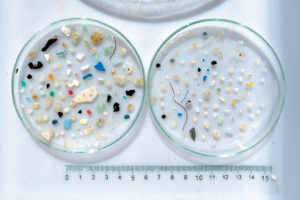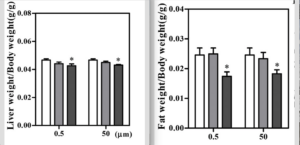 Background
Background
Over the last decade, plastic has become a more and more concerning source of pollution. In 2013 alone, almost 300 million pounds of plastic were produced worldwide (Lu et al 2017). Microplastics are defined as any plastic particle smaller than 5mm in diameter. Microplastics have been well documented as health concerns for marine life as more plastic accumulates in the ocean than any other place on earth. Additionally, microplastics have been found in a variety of household products including toothpaste and cosmetic products. We are just beginning to understand the extent microplastics have infiltrated our environment as well as our bodies, let alone the health risks they pose. One area of study deserving attention is the effect these plastics have on the microbiome of an organism. A microbiome is all of the bacteria, fungi, and viruses that live within or on a specific organism. Some of these microorganisms provide essential services to their host and maintaining a healthy microbiome has been tied to overall organismal health. Past studies have linked altered microbiomes to everything from obesity (Ridura et al 2013) to asthma (Stein et al 2016).
Central Question
A recent study from the Zhejiang University of Technology aimed to explore this relationship between the presence of microplastics and the gut microbiome of terrestrial organisms. Liang Lu and his team of researchers wanted to know if a diet that included microplastics would decrease the diversity of bacteria in the intestines of mice (Lu et al 2017). Mice were used because they are a historically good model for terrestrial organisms, and polystyrene (a common microplastic) was added to their food. In addition to looking at the effect this had on the microbiome, this study also asked how plastics affect the liver, and overall fat content of mice. Effects of microplastics on fat content and the liver were included in this study in order to track the overall health of the mice outside of a microbial context over the course of the study.
Results
In Lu et al’s study, lab grown mice were fed on a diet of normal food and microplastics over the course of five weeks. After this time the mice were killed and dissected so that researchers could study how the plastics affected the microbiome living in the digestive tract of the mice. Researchers found that after five weeks on a diet of microplastics mice had a significantly less diverse gut microbiome than before the microplastic diet started. This diversity was measured by taking samples from the mouse cecum (large intestine), and then quantifying the amount, and type of bacterial DNA present. These results are expressed below in Figure 1. The mice were fed either 0.5μm diameter microplastics or 50μm diameter microplastics. From the graph we can see that among the four main types of bacteria (Firmicutes, Bacteriodetes, Actinobacteria, α-proteobacteria) present, Firmicutes, Actinobacteria, and α-proteobacteria showed significant decrease in abundance.

Below, Figure 2 shows graphs of liver and total fat weight in the microplastic exposed mice. All colors represent the same thing as in Figure 1. From these graphs we can see that only when mice were exposed to the 1000μg per liter microplastic concentration diet was there a significant loss of liver weight or fat.

Overall, the results of this study show negative effects of dietary microplastic exposure on mice. As stated above, significant changes in gut bacterial abundances are correlated with many diseases and negative side effects. Additionally, the loss in liver and fat weight proves a decrease is overall health in mice that were exposed to 50μm diameter microplastics.
Future Questions
Eventually research should be done on the long term effects of continual microplastic exposure on microbiome health. This paper only focused on the exposure of mice to microplastics for 5 weeks, yet we can infer that due to a long biodegradation, time most organisms are exposed to microplastics over the course of their entire lives. While it is unethical to do an experiment of this type on humans, it is possible to transplant the gut microbiome of humans into mice. Replicating a study similar to Lu et al’s but with a human gut microbiome in the mice would lend more information on how plastics affect humans specifically. I would expect similar results to be found in an experiment on human bacteria. Lastly, this study was done specifically with polystyrene plastic. While polystyrene is one of the most common types of microplastic, many other types exist in our environment. Depending on the type of plastic used, different plastic additives (PAs) such as pigments may be present. (Fries et al, 2013) Therefore, other plastics like polyethylene or polypropylene may produce different results when fed to mice.
Additional Resources
- Lu, L., Luo, T., Zhao, Y., Cai, C., Fu, Z., & Jin, Y. (2019). Interaction between microplastics and microorganism as well as gut microbiota: A consideration on environmental animal and human health. doi: 10.1016/j.scitotenv.2019.02.380 A review study that explains the result of much of the research done on this topic. This review also places a greater emphasis on the application of this research on human health.
- Qiao, R., Sheng, C., Lu, Y., Zhang, Y., Ren, H., & Lemos, B. (2019). Microplastics induce intestinal inflammation, oxidative stress, and disorders of metabolome and microbiome in zebrafish. Science of the Total Environment, 662, 246-253. doi: 10.1016/j.scitotenv.2019.01.245 A similar study to the one presented in this blog post, but zebrafish instead of mice were used. Despite the difference in organism, similar results are found.
- Here, a Ted talk explains the extent to which microplastics have invaded our bodies and environment. Explains specific negative health effects caused by microplastics unrelated to the microbiome.
References
- Lu, L., Wan, Z., Luo, T., Fu, Z., & Jin, Y. (2018). Polystyrene microplastics induce gut microbiota dysbiosis and hepatic lipid metabolism disorder in mice. Science of the Total Environment, 631, 449-458. doi: 10.1016/j.scitotenv.2018.03.051
- Fries, E., Dekiff, J. H., Willmeyer, J., Nuelle, M. T., Ebert, M., & Remy, D. (2013). Identification of polymer types and additives in marine microplastic particles using pyrolysis-GC/MS and scanning electron microscopy. Environmental Science: Processes & Impacts, 15(10), 1949-1956. 10.1039/c3em00214d
- Lu, L., Luo, T., Zhao, Y., Cai, C., Fu, Z., & Jin, Y. (2019). Interaction between microplastics and microorganism as well as gut microbiota: A consideration on environmental animal and human health. Science of the Total Environment, 667, 94-100. doi: 10.1016/j.scitotenv.2019.02.380
- Qiao, R., Sheng, C., Lu, Y., Zhang, Y., Ren, H., & Lemos, B. (2019). Microplastics induce intestinal inflammation, oxidative stress, and disorders of metabolome and microbiome in zebrafish. Science of the Total Environment, 662, 246-253. doi: 10.1016/j.scitotenv.2019.01.245
- Fackelmann, G., & Sommer, S. (2019). Microplastics and the gut microbiome: how chronically exposed species may suffer from gut dysbiosis. Marine pollution bulletin, 143, 193-203. doi: 10.1016/j.marpolbul.2019.04.030
- Bollendorff, S. (2019) Microplastics sample taken from the Great Pacific Garbage Patch at 34°42’210 N – 142°21’004 W. [Photograph]. Tara Expeditions Foundation.
- Ridaura, V. K., Faith, J. J., Rey, F. E., Cheng, J., Duncan, A. E., Kau, A. L., … & Muehlbauer, M. J. (2013). Gut microbiota from twins discordant for obesity modulate metabolism in mice. Science, 341(6150). doi: 10.1126/science.1241214
- Stein, M. M., Hrusch, C. L., Gozdz, J., Igartua, C., Pivniouk, V., Murray, S. E., … & Neilson, J. W. (2016). Innate immunity and asthma risk in Amish and Hutterite farm children. New England journal of medicine, 375(5), 411-421. doi:
